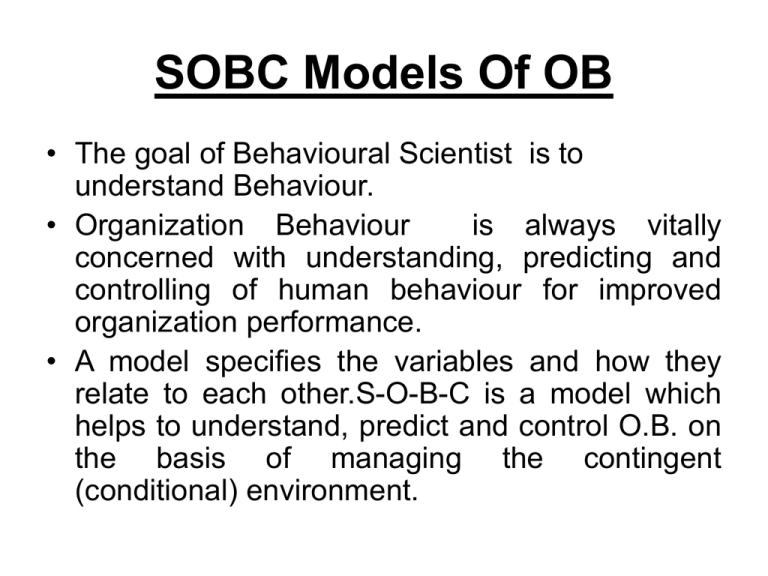SOBC Model of Organizational Behavior: Presentation
advertisement

SOBC Models Of OB • The goal of Behavioural Scientist is to understand Behaviour. • Organization Behaviour is always vitally concerned with understanding, predicting and controlling of human behaviour for improved organization performance. • A model specifies the variables and how they relate to each other.S-O-B-C is a model which helps to understand, predict and control O.B. on the basis of managing the contingent (conditional) environment. • In this case the internal factors which are cognitively oriented and external environmental factors which are behaviouristically oriented become important. • In S-O-B-C model : S Stimulus B Behaviour O Organism C Consequence • Based on the Social learning frame work the model recognizes the interaction of • S+C (Environment) | • Interpersonal | • O (Cognitive) | Variables • B (Behavioural) | • The model may be splitted into two ways • S-B-C model emphasizes need to identify observable contingencies (S+C) for prediction and control of behaviour. OR • O-B model emphasizes internal cognition lead to behaviour. • Thus the expanded S-O-B-C model recognizes interactive nature of both environment (S+C) AND Person’s cognition (O) in determining behaviour. • S Variable is stimulus or more broadly the environmental situation with respect to Organization environment it represents a macro perspective that includes organization Policy, Organization Structure and decision making. • O Human organism more specifically cognitive process. It includes his perception, Personality, Motivation. • B Behaviour is anything a person does. • C Consequence which is again environmental one. Outcome of the behaviour (Covert) Specific behaviour (Overt) • The worker started the m/c • The worker push the button • The ,,produces many pcs. of items • The ,, moved his arms & hands very fast • The ,, did not produce many pcs. Of items • The ,, ,, ,, ,, ,, very slow • The ,, come to work late • The ,, walked very slowly to his workplace from the gate • The ,, ,, • The ,, ,, ,, on time ,, ,, ,, fast ,, • O.B. mostly deals with the overt kinds of behaviour which are directly observable or measurable. • MOTIVATION Contribute in this Behavioural part. • LEADERSHIP Interactive nature of variables } • S----O } Stimulation & Organism means } situation & persons } interaction before behaviour results. • • B----C } IF-THEN relationship } If the person behaves a certain way , then a } particular consequence will follow. Such } contingent consequence can be } used to predict & control behaviour. There is a continuous interaction between the variables & when the expanded nature of these variables is recognized, it is clear that O.B. is very complex indeed. In the From of an Organization : S-O-B-C MODEL is • S O Organization Environment (structure) Organizational Dynamics (Grp./Selection) Participant Communication/Apprisal/ (Cognitive self Conflict/Leadership) mgmt Process) / Org. Dev) O.B. & Consequence Application • S Environmental situation, both contextual & organizational. • O Cognitive understanding of organizational participants that mediates. • Between environmental situation and organization behaviour. • B Organization behaviour • C Organizational & Group dynamics and consequences that result from previous interactions among environmental, personal and behavioural variables. • S-O-B-C model gives us bare bone sketch of organizational behaviour. It serves as conceptual framework. SOBC application to human resource management depends upon leader’s ability to bring into awareness the overt and covert antecedents and contingent consequences that regulate the leader are and subordinates performance behaviour. In this leadership application, the followers are actively involved in the process and together with the leader they concentrate on their own and one another’s behaviours, the environmental contingencies and their mediating cognition. Examples of SOBC approach of OB are :• 1. Leader becomes acquainted with the macro and micro variables that control his own behaviour. • 2. The leader works with the subordinate to discover the personalized set of behavioural contingencies that regulate the subordinate’s behaviour. • 3. The leader and subordinate jointly attempt to discover ways in which they can manage their individual behaviour to produce more mutually reinforcing and organizationally productive outcomes. • In such a situation, the leader and subordinate have a negotiable, interactive relationship and are consciously aware of how they can influence each other’s behaviour by giving or holding back desired rewards.





